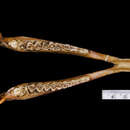Biology
(
anglais
)
fourni par Arkive
Peter's duikers are active only during the day (2), and like all duikers, have a secretive life (4), favouring dense undergrowth where they can hide from potential predators (6). Their diet is composed primarily of fruits, which are often picked from the forest floor (3), with the remainder consisting of leaves (2), and small amounts of flowers and fungi (3).
Duikers give birth to only a single calf at a time, which then hides in vegetation for the first few weeks of life (4). Peter's duikers are believed to be territorial animals (2), and the large scent glands beneath each eye may be used to mark their territory, by rubbing them on trees (4).
Conservation
(
anglais
)
fourni par Arkive
Peter's duiker occurs in several protected areas, such as the Lope and Sette-Cama Reserves in Gabon (6). However, in addition to effectively protected areas, further measures may be required to prevent populations from declining under the pressure of bushmeat hunting. It may be necessary to manage wildlife populations outside parks, to ensure both the continued availability of bushmeat for human consumption, and the continued survival of the species (6).
Description
(
anglais
)
fourni par Arkive
Peter's duiker belongs to a group of shy, secretive African mammals that are most often glimpsed as they dive for cover in thick vegetation (4). It is a fairly large duiker, with a coat that varies between pale tawny, rich russet and dark brown (2), and a broad, dark band runs from between the shoulders, along the spine, and expands over the rear flanks (3). Whatever the coat colour, a tuft of russet-coloured hair sits upon the forehead between the short, pointed horns (2) (3). The forehead of Peter's duiker is one of the most heavily reinforced of any duiker species, with the dense bone measuring up to 13 millimetres thick in some males (2).
Habitat
(
anglais
)
fourni par Arkive
Peter's duiker occurs in moist equatorial forest in both lowland and montane areas. They prefer areas with dense undergrowth in which they can shelter (2).
Range
(
anglais
)
fourni par Arkive
Occurs in central Africa, with a range extending from Cameroon and Gabon eastwards to Kenya and Tanzania (1).
Status
(
anglais
)
fourni par Arkive
Classified as Least Concern (LC) on the IUCN Red List (1).
Threats
(
anglais
)
fourni par Arkive
Classified as Near Threatened by the IUCN, Peter's duiker is vulnerable to the impact of hunting (1). It is the third most frequent species hunted for bushmeat in Gabon, where bushmeat is an important source of protein for both urban and rural people (6), and in the Central African Republic, Peter's duiker accounted for 29 percent of all animals captured in snares (7). Even with optimistic estimates of population density, snare hunting at this level is unsustainable for Peter's duiker (7). In addition, the loss and degradation of critical forest habitat, through human settlements and infrastructure development, threatens the future of Peter's duiker (1).
Peters' duiker
(
anglais
)
fourni par wikipedia EN
Peters' duiker (Cephalophus callipygus) is a small antelope found in Gabon, Equatorial Guinea, southern Cameroon, and northern Republic of the Congo.
Peters' duikers typically weigh about 40 lb (18 kg), and are about 20 in (50 cm) at the shoulder. They have grey-brown coats, and live in dense undergrowth in mountain rainforests. The total population is estimated at 380,000 individuals, with a declining trend.
References

- licence
- cc-by-sa-3.0
- droit d’auteur
- Wikipedia authors and editors
Peters' duiker: Brief Summary
(
anglais
)
fourni par wikipedia EN
Peters' duiker (Cephalophus callipygus) is a small antelope found in Gabon, Equatorial Guinea, southern Cameroon, and northern Republic of the Congo.
Peters' duikers typically weigh about 40 lb (18 kg), and are about 20 in (50 cm) at the shoulder. They have grey-brown coats, and live in dense undergrowth in mountain rainforests. The total population is estimated at 380,000 individuals, with a declining trend.
- licence
- cc-by-sa-3.0
- droit d’auteur
- Wikipedia authors and editors

